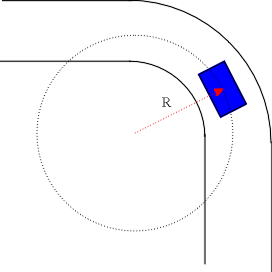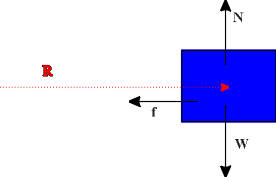|
Example: Rounding a curve
To see how we
use the centripetal acceleration equation let's look at an example.
A car of mass m
rounds a curve at a constant speed as shown below. The curve has a radius
of curvature of R. (In other words, the curve is a piece of a circle of
radius R.) If the coefficient of static friction between the road and the
tires is m, what is the maximum speed the car
can travel around the curve without slipping?

The free-body
diagram of the car ( from a back view) is shown below.

In the vertical
direction we find

In the
horizontal direction

But we know
that, (for maximum static friction),

and
 . .
In requirement
that the car move in a circle allows us to use the centripetal
acceleration formula.

So putting it
all together gives

or, that the
maximum velocity without slipping on the road is

Notice that this
expression has the right properties: the max velocity is reduced when the
friction coefficient is reduced and the velocity is also reduced when the
radius of the curve is reduced (making it a tighter turn). |